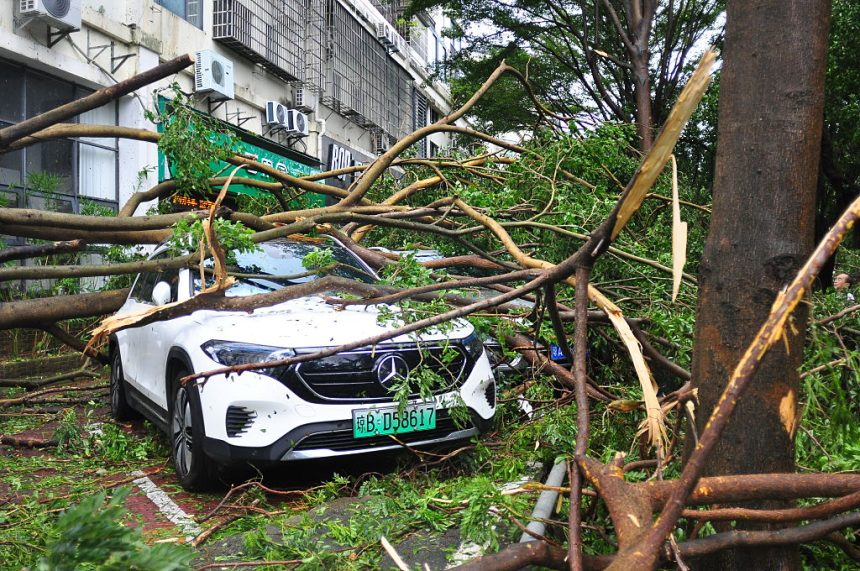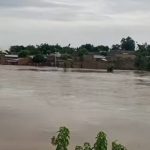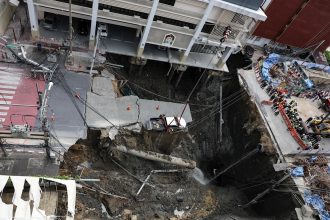Damage from Typhoon Kajiki in Sanya, Hainan Province of China, on Aug. 25, 2025. Credit – Sun Qing—VCG/Getty Images
Vietnam began evacuating more than half a million people Sunday in preparation for a powerful typhoon, which made landfall on the country’s coasts on Monday afternoon.
Typhoon Kajiki, which drenched China’s Hainan Island and parts of Guangdong province on Sunday evening, forced mass evacuations, school and airport closures, and emergency preparations in Vietnam’s coastal provinces from Thanh Hoa to Quang Tri. The typhoon hit Vietnam’s coast with winds of up to 133 km/h (82 mph) and was moving inland as of Monday 4 p.m. local time (5 a.m. ET). The wind is expected to rapidly weaken over land, according to the Joint Typhoon Warning Center (JWTC).
At least three people have been killed. The storm also left at least 13 people wounded, damaged close to 7,000 homes, and flooded 28,800 hectares of rice fields, Vietnamese authorities said. Several provinces, including Thanh Hoa, Nghe An, Ha Tinh, Thai Nguyen, and Phu Tho experienced blackouts after the storm brought down 331 electricity poles.
The storm dissipated in intensity in Vietnam by Monday evening local time (Monday morning E.T.), although strong winds continued into Tuesday morning and Vietnam’s National Center for Hydro-Meteorological Forecasting said that some areas will continue to experience heavy rain through Tuesday.
Kajiki is also expected to affect Laos, northern Thailand, eastern Cambodia, and central Myanmar, according to the World Meteorological Center Beijing. The storm was downgraded to a tropical depression as it entered Laos on Tuesday morning local time (Monday night E.T.) with wind speeds of up 88 km/h (55 mph). Thai authorities issued weather alerts for 58 provinces in Thailand and warned that Kajiki may lead to flash floods and landslides in the North and Northeast on Tuesday evening. Waves in the upper Andaman Sea and upper Gulf of Thailand are forecast to reach up to 3 m (9.8 ft).
“This is an extremely dangerous, fast-moving storm,” the Vietnamese government said in a statement Sunday.
“Strong winds can last for hours. When the storm passes, it may temporarily calm down but then increase in intensity,” Vietnam’s Deputy Prime Minister Tran Hong Ha said on Monday morning, adding that “floods and landslides are sometimes more dangerous than storms.
Here’s what to know.
Vietnam braced for powerful storm
The Vietnamese government earlier expected Kajiki, the fifth tropical storm to hit the country this year, to be as powerful as Typhoon Yagi, which brushed Vietnam’s north last year—killing 300 people in the country and leaving more than $3 billion in damages in its wake.
Meteorologists from Vietnam’s national weather agency described Kajiki as a “very unusual” typhoon, local media reported, saying its rapid movement was alarming.
Kajiki was also expected to bring in torrential rains to Vietnam: VnExpress reported that some areas could receive as much as 40 cm (15 in) of rain, and some places may experience downpours of 20 cm (7 in) in just three hours. Vehicles on National Highway 6, connecting Hanoi to northwestern provinces, stalled as water levels reached nearly 1 m (3.2 ft), according to VnExpress.
Prime Minister Pham Minh Chinh has issued dispatches to ministers, local government leaders, and other officials, ordering the immediate evacuation and relocation of residents in dangerous areas. A Sunday government statement said that more than 16,500 soldiers and 107,000 paramilitary forces were on standby to assist in disaster response and relief efforts.
Two airports in Thanh Hoa and Quang Binh provinces closed down on Monday for the safety of passengers. Local carriers Vietnam Airlines and Vietjet have also cancelled flights.
The Railway Transport Joint Stock Company also suspended some scheduled passenger train services plying Hanoi-Ho Chi Minh routes because of the storm.
Fishermen in central coastal areas where the typhoon will pass were called back to dock and anchor their ships.
Southern China also shut down
Southern China’s Hainan Island saw heavy rainfall and gales as the typhoon brushed past the island on Sunday. The island’s Sanya City, a popular tourist resort destination, closed businesses and public transport as it braced for the intensifying storm. Around 20,000 people in Hainan were evacuated, and more than 30,000 fishing boats were recalled to ports, according to state news agency People’s Daily.
China’s national weather agency forecast that Hainan, southwestern coastal areas of Guangdong, and other coastal areas will experience torrential rain of up to 25 to 35 cm (10 to 14 in), and that strong winds could continue to affect coastal areas of Hainan, Guangxi, and Guangdong till around 2 p.m. Tuesday local time (2 a.m. E.T.). Yunnan, Guangdong, Hainan, and Guangxi are also forecast to receive heavy rain till Tuesday.
Chinese authorities issued a yellow alert, the third highest level of a four-tier warning system, on Monday.
The country was recently battered by torrential rainfall which caused flooding and landslides, which killed at least 30 people in Beijing, forced more than 80,000 people to evacuate, and impacted electricity in around 130 villages.
How to stay safe in a typhoon
The U.S. embassy in Vietnam recommended that people take the following precautions:
-
Monitor local media and weather forecasts;
-
Follow instructions from local officials;
-
Avoid walking or driving across flooded areas.
Contact us at letters@time.com.









